Nice to know that should Clint Eastwood choose to continue directing, he has a future career with Lifetime movies or any sundry movie-of-the-week productions as that is exactly what his latest big screen foray with SULLY is. That’s not to say there’s anything wrong with Lifetime movies. I have watched more than my fair share over the years as I am sure many of you have. While solid workmanship, there’s a reason those films are “made for tv” and that’s exactly where SULLY belongs; on tv and not on the big screen.

We all know the story of the “Miracle on the Hudson”; those electrifying 24 minutes following the emergency water landing into the Hudson River of US Airways flight 1549 and the rapid response and rescue by New York’s finest of all 155 souls on board. The world collectively held its breath and watched and waited as the huddled masses on the wings of an aircraft and bobbing in life rafts were plucked from near death one by one from the icy waters on that frigid January 15th in 2009. And while that is story enough in and of itself, the real story lay with pilot Captain Chesley “Sully” Sullenberger, the man who guided the aircraft and his passengers to safety after a bird strike took out both engines of the plane shortly after take-off from La Guardia. For days and weeks we saw Sully paraded endlessly before the media, entertainment, late night and news alike. We heard from the survivors and the crew. And we heard from Sully himself, quiet, humble; a man “just doing his job.” But there was more happening out of the spotlight. NTSB investigations and bureaucratic machinations, and a man appearing rock solid and unwavering on the outside, while suffering PTSD nightmares and self-doubt within.
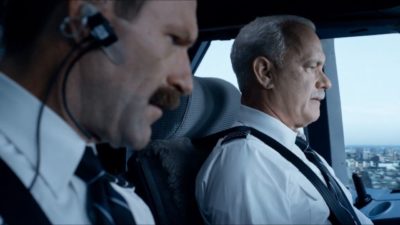
Written by Todd Komarnicki based on the best-seller “Highest Duty” by Captain Sullenberger and Jeffrey Zaslow, in Eastwood’s capable directorial hands, one hoped for insight and exploration into the unknown and lesser known aspects of the “Miracle on the Hudson”, including what makes Captain Sullenberger tick. Appearing to all as unflappable and unflinching, cool-headed in a crisis, as the book revealed, there was more to the book of Sully Sullenberger than his cover revealed. Unfortunately, Komarnicki and Eastwood only give us crumbs, electing instead to focus on ad nauseam flawless computer CGI recreations of the entire event from bird strike to landing to rescue, and then sparsely peppering the cinematic terrain with introspection and the behind-the-scenes story. However, that introspection coming from Tom Hanks as Sully Sullenberger is well worth a look. Just too bad there’s such a short look.
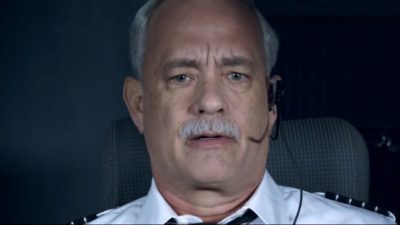
There is no one but Tom Hanks who could play Captain “Sully” Sullenberger. With his now patented Jimmy Stewart everyman, heroic everyman demeanor, Hanks is the draw of SULLY. With few words, he lets his eyes speak for him. We feel Sully’s pain and worry as he awaits word of “the count” , the number of souls rescued, as he wonders if he did all that he could do or if he did the right thing. The self-doubt expressed is resonant, poignant and humanizing. The welling tears in his eyes as the camera moves in tight while we collectively hear the magic “155″, sums up the man and Hanks’ performance. That one image tells the entire emotional story. In the hands of a lesser artisan, the film as a whole would have been relegated to some tv movie-of-the-week from the start, but even with minimal dialogue and personal story not spelled out, Hanks leads with nuance and celebrates the quiet, letting us know there is more to the man than his flawless exterior.
Through repetitive cut-away phone calls between Hanks and a very very under-used Laura Linney who plays wife Lorraine, we get glimpses into the Sullenberger home life – money is a concern, Sully has just started a side business as an aviation safety expert, they own two homes and may lose one and possibly two if NTSB hearings go awry. Like most Americans, the Sullenbergers appear to be living paycheck to paycheck (mind you, in a very nicely apportioned home and neighborhood). But those snippets are too few and you find yourself wanting to know more. Who knew he had a side job as an aviation safety expert? Tell us more.
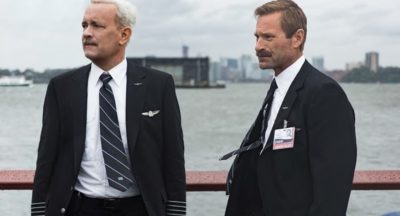
More does come thanks to the pairing of Aaron Eckhart as Sully’s co-pilot Jeff Skiles. A bit more verbose and definitely with more of an edge and public persona than Sully, Eckhart gives Skiles a more playful, and sometimes biting, edge than Hanks gives Sully, staying true to their real life counterparts. (Side note to Eckhart – the porn style moustache is not a good look.) It’s an interesting dynamic to watch unfold, especially when you compare their relationship on the ground with that in the cockpit.
During the 208 seconds in the cockpit as they ascertain the situation, think on their feet and safely execute an unprecedented landing, Hanks and Eckhart are a well-oiled machine. You can almost see the wheels turning in Hanks’ head with Eckhart completely in tandem. Of course it takes until the third act to see this sequence play out uncut in a single scene as the scene has been intercut in 10-15 second clips throughout the film, interspersed with what’s happening in the passenger cabin, on the ground and in the La Guardia air traffic control tower. Thankfully, you are still interested in seeing it played out one more time.
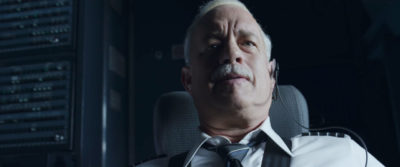
At both the public and closed-door NTSB hearings, Hanks and Eckhart say little, but the dialogue they do have comes across as confident, challenging and, in the case of Eckhart’s Skiles, a bit cocky, not to mention infusing some humor into the mix. But it works.

The NTSB hearings are some of the most interesting things to come out of SULLY. Little did anyone realize that while Sully and Skiles were being lauded for their efforts, the NTSB was trying to find fault with them. It was the NTSB’s contention that Sully and Skiles could have safely made it back to La Guardia or on to Teterboro after the bird strike and safely landed the plane in both cases. Protocol and simulations indicated that was the proper thing to do. Sully’s argument was that he “felt” the second engine go despite what the NTSB was stating. Thanks to strong performances by Anna Gunn and Mike O’Malley as lead NTSB investigators, the cold callous nature of their characters show them impervious to “the human factor” or “human connection.” In true Eastwood fashion, the undertone of the NTSB hearings smacks of a slap on the hand to the airlines and NTSB as you get the sense the greater concern was that they lost an airplane as opposed to saving lives. Sadly, the depiction of the hearings and the information imparted is done so on a very simplistic level, leaving one craving more. With this film in particular, it’s as if Eastwood opened Pandora’s box just a sliver so as only to let out bits and pieces of the whole story and then rapidly closed it before too much was revealed.
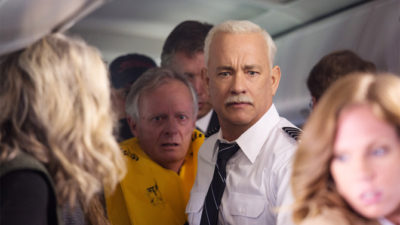
Riveting is Patch Darragh. As air traffic control operator Patrick Harten, Darragh is scene stealing as Harten gets the distress call from Flight 1549 and hears the words “both engines” are out. Calmly, yet anxiously, Darragh’s demeanor intensifies both vocally and visually as Eastwood cuts between the air traffic control and the cockpit. His fear is palpable, especially as other operators come into screen and the flight is then lost on radar.
Among the supporting cast we find many familiar faces as passengers and crew – Jeffrey Nordling, Valerie Mahaffey, Molly Hagen, Ann Cusack, Max Adler, Jerry Ferrara, and a longtime fave of mine Marcia DeBonis, just to name a few. Michael Rapaport also has a nice turn as a star struck bartender named Pete. And yes, even Katie Couric is on hand to report the story and interview Sully, both in Sully’s nightmares and in life. (Big continuity error with the Couric scenes as in the same interview sequence, a shot of her hands shows no rings and in the next shot, she’s got diamonds on her fingers. Glaring oversight early in the film that I would never expect from Eastwood.)
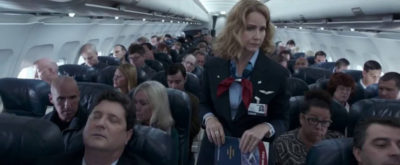
Two brief scenes have Sully recalling his early days of flying – one as a 16-year old in a biplane, the other in a fighter jet in the 60’s complete with engine flame-out and rough landing. Feeling as if inserted as after-thoughts to remind us Sully Sullenberger had been flying “his whole life”, they feel empty and gratuitous at best.
Eastwood’s long time cinematographer Tom Stern is back and as usual, delivers solid visuals, most notably with close-ups of Hanks in very introspect moments, while he soars when lensing cockpit scenes, and the plane evacuation with frantic passengers clamoring and climbing over one another exiting into the water, immersing the audience in the immediacy and urgency of the situation. Thankfully the lensing is so spot on given that with a 24 minute rescue, a 208 second cockpit emergency and scant else for story, much of what we see are the passengers leading up to the flight and the evacuation.
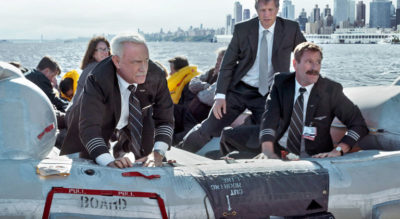
One of the most controversial aspects of SULLY comes with the depiction of Sully’s nightmares. They are all the same. He crashes a plane into different buildings in New York as he imagines the bird strike, the engine failures. In one nightmare, he’s heading back to LaGuardia and crashes. In another Teterboro, and crashes. In another, just a straight on fly through. The film opens with one of these crashes. While this is undoubtedly a nightmare that many pilots have had during the course of their careers, the question here is whether it is appropriate for these scenes to be in this film, set in New York, with a release date the weekend of the 15th anniversary of 9/11. The images are chilling each time they appear on screen. Might they be an important component to building the character of Captain Chesley “Sully” Sullenberger? Yes, if the film were actually digging deeper into the man, his life’s journey and what makes him tick. It would be appropriate just for a general release of a film. But, given the release date of September 9th? Warner Bros. should have thought twice or even thrice on this one.

Questionable is Eastwood’s end credit scoring. For a story with a happy ending and a solid citizen, all-around great guy as your hero, something inspirational and upbeat would have been more welcoming than sounds akin to a funeral dirge. However, do stay through the credits for a scripted reunion of Sully, wife Lorraine, and the passengers of Flight 1549. Those snippets are as patriotic as can be!
Despite strong performances from Tom Hanks and Aaron Eckhart, and strong visuals from Tom Stern, SULLY is weak on script and story. Conflict is minimal. There is no moral dilemma to pull us in. And tidbits that spark interest go the way of birds into a plane engine. The film’s genesis may have been “Miracle on the Hudson” but SULLY is no miracle on film.
Directed by Clint Eastwood
Written by Todd Komarnicki based on the book “Highest Duty” by Chesley “Sully” Sullenberger and Jeffrey Zaslow
Cast: Tom Hanks, Aaron Eckhart, Laura Linney, Anna Gunn, Mike O’Malley, Jamey Sheridan












